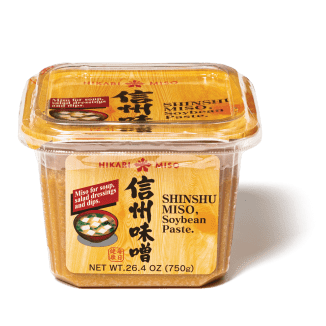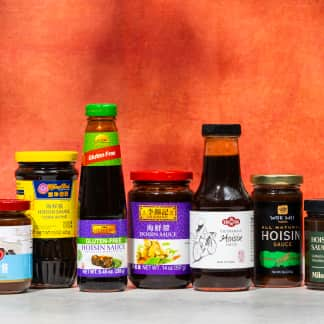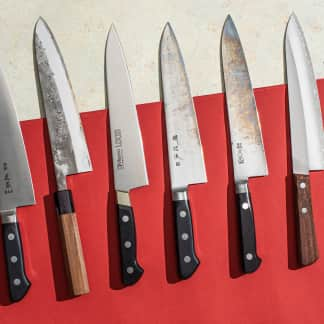Miso is a traditional Japanese household staple that goes back a millennium. Depending on the variety of miso, the color can range from beige to chocolaty brown to deep mahogany red. Its consistency varies, too, from smooth and paste-like to sandy and chunky. In general, it has a fragrant aroma and complex, deeply umami flavor.
Our Tasting Lineup
We tasted a variety of miso that’s been aged between a couple of months and two years. Generally, the darker the appearance, the more intense the flavor.
 Hikari Saikyo Sweet Miso Hikari Saikyo Sweet Miso |
 Hikari Shinshu Miso White Hikari Shinshu Miso White |
 Sano Miso Mori no Jukuo Miso Sano Miso Mori no Jukuo Miso |
 Shirakiku Red Miso Soybean Paste (Aka Miso) Shirakiku Red Miso Soybean Paste (Aka Miso) |
 Maruman Mutenka Aka Miso Maruman Mutenka Aka Miso |
 Mutenka Shinshuichi Tomegamajikome Aka Miso Mutenka Shinshuichi Tomegamajikome Aka Miso |
 Nomura-San Awase (Mixed) Miso Nomura-San Awase (Mixed) Miso |
 Sano Miso Country-style Jindai Miso Sano Miso Country-style Jindai Miso |
 Sano Miso Okazaki Hatcho Miso Sano Miso Okazaki Hatcho Miso |
 Sano Miso Sakurajima Miso Sano Miso Sakurajima Miso |
|---|
According to William Shurtleff and Akiko Aoyagi, authors of The Book of Miso (1983), the predecessor of miso originated in China some 2,500 years ago as a fermented soybean paste–like ingredient called “jiang,” or “sauce” (in its closest English translation). It was brought to Japan in the seventh century by Buddhist monks. Since then, jiang has been transformed by craftspeople and farmers into miso and other fermented Japanese ingredients with their own distinctive styles and characteristics.

Today, many people in Japan start their day with a bowl of miso soup, which is the most common use for this incredible ingredient. It’s also used in a wide variety of other applications, from marinating fish and meat to pickling and preserving vegetables. It can also serve as a dip, balance flavors in desserts, and provide a finishing touch to cooked dishes.

How Is Miso Made?
As with many Japanese fermented foods such as shoyu and natto, the miso fermentation process starts with inoculating rice, barley, and soybeans with koji (Aspergillus oryzae), a cultivated fungus. As koji interacts with cooked grains over the course of a few days, it converts the starch in the grains to sugar and the protein in the grains to amino acids, one of which is savory glutamic acid. The inoculated grains are then mixed with cooked soybeans and left to ferment for anywhere from a few weeks to years. Younger miso, which is fermented for a short period of time and has more not-yet-converted starch, has a higher sugar content than the more aged versions; as a result, young miso tends to be sweeter and fruitier, with some sake-like winey notes, whereas aged miso leans meatier, more complex, and more savory. The koji-to-grains-and-beans ratio also affects the flavor of the miso; the higher the koji content, the sweeter the paste.
How Is Miso Made? Ask Paul
And what are the different kinds?The beans and grains that are used to feed the koji vary depending on where the miso is made and determine the type of miso, such as rice for kome, soybeans for mame, or barley for mugi. However, the vast majority of miso made in Japan (82 percent in 2023) uses rice koji as a starter and therefore most misos you find at grocery stores are kome misos, according to Yuichiro Hirano, spokesperson for Japan External Trade Organization (JETRO).
How Long Does Miso Last?
This incredible fermented ingredient is essential in Japanese pantry. How long does it stay fresh?The World of Miso
There are more than 1,300 varieties of Japanese miso. Within the biggest category, kome miso (rice miso), there are two main subcategories: beige shiro miso (also known as white miso) and darker brown–looking aka miso (also known as red miso). Both are readily available at grocery stores in the United States. The key difference between shiro miso and aka miso is how the soybeans are prepared. Boiled soybeans are used to make shiro miso. “Sugar and protein get washed away, which prevents coloring the miso,” said Shohei Miyajima, the general manager of Japanese specialty food shop Dashi Okume in Brooklyn, New York. “For aka miso, you steam the beans so [the miso] doesn’t lose sugar and protein,” Miyajima explained. And the fermentation period is longer for red miso than for white miso, which makes the color of red miso darker.
The climate of the southern Japanese island of Kyūshū is mild and temperate, so a lot of barley is grown there, said Ayako Yuki, who runs a business called The House of Umami that helps connect American chefs with small-batch products from farmers in Japan. Because barley grows well in Kyūshū, the barley-based mugi miso is produced there. In much of the country, rice-based kome miso takes precedence, with small pockets of soybean-based mame miso dotting the eastern part of Honshu, Japan’s main island.
5 Ways to Use Miso, the Home Cook’s Secret Weapon
This delicious ingredient is a multitasker in the kitchen and can help in ways you might not even know.When assembling our tasting lineup, we considered a number of regional Japanese misos that have made their way to the United States and are available in grocery stores, including common Japanese household shiro and aka miso brands such as Hikari, Maruman, and Horikawaya Nomura. We also chose a few connoisseurs’ picks from online retailers that carry more niche varieties, such as the hard-to-find hatcho miso that is fermented for three years; a barley-based mugi miso; and a rustic, farm-style inaka miso (“inaka” means “rural”). Before commercially produced miso became popular in Japan, most farmers in the countryside prepared their own miso; though commercial brands have largely replaced inaka miso because of their convenience and availability, the tradition of making inaka-style miso remains. Finally, we included an awase (“mixed”) miso because some households in Japan prefer blending different types of miso together to bring out the desired flavor of each.
Tasting Miso
We tasted each miso in three ways: plain, as a dip with cucumbers (as advised by JETRO), and mixed into a homemade dashi. Our panelists consist of test cooks and editors, as well as Japanese chefs. Tomohiro Shinoda, the chef from acclaimed udon restaurant Yume Ga Arukara in Boston, Massachusetts, joined our tasting with his mother, Akemi Shinoda, an avid home cook who advised us on miso’s regional differences.
The colors of the misos we tasted were vastly different, from beige and golden to caramel and dark chocolate; they also varied in texture, from “whipped” to “fudgy.” Some evoked the fragrance of champagne and some were barnyardy like an aged alpine cheese. Some tasters likened a sweet miso to the flavors of “orange rinds” and “kinako” (which is a roasted soybean flour typically used as a dusting powder for Japanese desserts that provides a layer of creamy, umami flavors to counter sweetness). When mixed with dashi, the flavors of some misos changed, as the thick paste blended with the savory broth.
How to Shop for Miso
The length of fermentation impacts a miso’s flavor. In our tasting, we found that the longer the fermentation, the darker and more savory the miso gets. If you prefer a sweeter miso, seek out a lighter-colored or rice-based product as a starting point. On the other hand, aged miso tended to have the winey, fermented, umami-rich notes that turned our heads. Those mature misos are savory and complex, lending a pack of flavors that are well-balanced between sweet and salty. The labels of most misos clearly indicate their styles; if not, look for clues in their ingredient lists for the types of grains used.


Some misos may have preservatives added to enhance their flavor or appearance. You may find riboflavin, a common color enhancer, on some labels (right). If you’re avoiding preservatives, look for labels that indicate it’s "mutenka" or preservative-free (left).
If you’re avoiding preservatives, look for “mutenka” on labels, a sign that the miso was produced without additives such as riboflavin, which is used to enhance color. If you’re watching your sodium intake, look for “genen,” which means “reduced sodium.”
Instead of ranking the misos we tasted, we provided tasting notes to help shoppers navigate the options. Each is distinctive and worth seeking out; like wine, there is no best miso, but rather a whole world to enjoy. We chose to list misos that contain rice first because rice-based products make up the bulk of miso production. We then sorted the rice-based misos from light (white) to dark (red), followed by one soybean-based miso and one barley-based miso. We were delighted by the variety of flavors we experienced, and we hope you enjoy exploring too.
- Sample plain
- Sample with cut cucumbers
- Sample in Ichiban Dashi




















